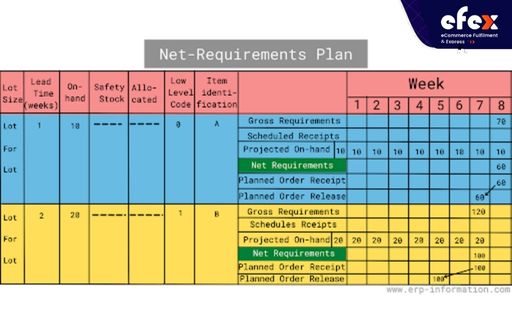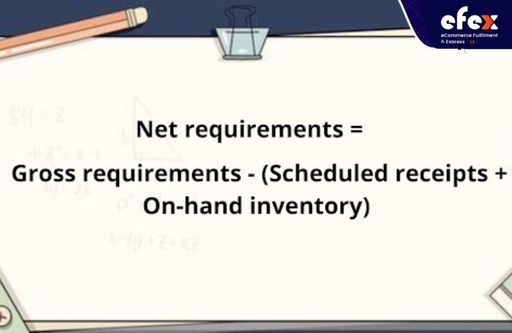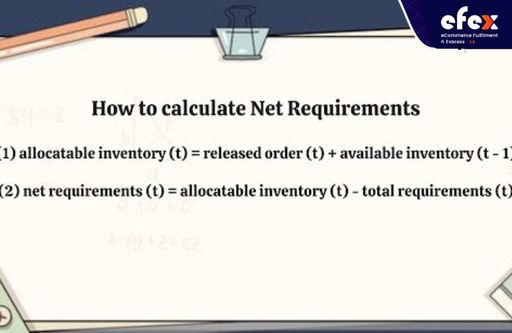
More Helpful Content
Net requirements can be challenging to determine, yet they are crucial for making sure that a business has the necessary stock on hand. Without precise net requirement computations, it's simple to hold either too much or not enough stock. This can result in shortages and lost sales opportunities.
A tool called Net-Requirement makes it simple to determine the net requirements of your company precisely. You'll constantly have the data you need to maintain your supply chain operating properly if you use this tool. Without any further ado, we’ll talk about the net requirement and its formula in today’s post. Let’s go!

Net requirements are considered as the amounts needed for a given item based on the gross requirements (derived from projections, customer orders, and upper-level needs), less any stock that is currently in stock and any scheduled receipts. We can determine the net requirements by examining the production's urgent needs or by using historic information.
👉 Read More: What Is SKU Rationalization? Process And Benefit
In order to avoid running out of inventory while awaiting an upstream source, it is crucial to take into account every link in a firm's supply chain when estimating net requirements. Producing enough products with the least amount of inventory is the objective.
The first step in this process is to calculate every material required for manufacturing, after which it is determined the quantity of raw material, as well as work-in-process, could be created in a specific amount of time.
👉 Read More: What Are Scheduled Receipts In MRP?
It is customary to create a brand-new planned order for a particular net requirement only after determining the impact of rescheduling any pending receipts to the necessary dates. (If the amount is less than the designated safety stock, a scheduled order depending on the batch size is generated.)

Let's define a few concepts first before discussing the net requirements. Gross requirements, inventory on hand, scheduled receipts, and the estimated available balance are examples of terms. Before starting operations, a company must determine its capacity. From this figure, the company can quickly determine the entire inputs or gross requirements. The term "gross" shows the total amount of materials that a business must provide for a production cycle to run well.
Gross requirement. A company's gross requirement is often specified and fixed.
Scheduled receipts. You can receive payments based on a predetermined schedule with scheduled receipts. You may, for instance, establish your account to process money from buyers each Monday morning. If you have to manage your cash flow or you have other recurring expenses, it would be quite useful.
On-hand inventory. Final goods that are held and available for delivery at any moment are referred to as on-hand inventory.
Inventory. This term is fairly broad and refers to keeping numerous products or raw materials. Businesses may even increase their stockpiles in anticipation of a significant sale before the holiday season. A business that has an effective and strategic inventory control and management system is always one step ahead of its rivals.
Due to their inability to precisely foresee what customers will want from a year to the next year, companies in this sector have had difficulty keeping up with supply and demand trends. Implementing net requirements planning, which makes use of statistical analytic methods like linear modeling techniques, is one solution.

After subtracting the additional value of planned receipts and on-hand inventory from gross requirements, net requirements are the necessary materials for the upcoming productive period. We total up the orders that are expected to come and the stock of material, then deduct these from the total needed. This figure represents the entire amount of materials required for the subsequent production cycle after netting. Likewise, that's explained by a straightforward net needs formula.

We carefully determine this value by examining the scheduled revenues and the merchandise that is currently on hand. As a result, it is not an arbitrary number and is not constant over all production cycles. The net required amount now has to be more than a certain safety stock. The value we acquire after contrasting the net value achieved with the company's safety stock is the projected available balance.
👉 Read More: What Is The Chase Production Strategy?
An order is placed for additional raw materials and inventory if it falls under the safety stock level. The amount of inventory anticipated for the future is the expected available balance. It is comparable to the number of inventory levels we keep over from one production cycle to the next. If the anticipated balance is less than:
A request is made for a prearranged content release. This guarantees a steady flow of materials into the production process.
It is determined by assigning the overall requirements relying on the MRP list to inventories and released orders. It serves as a planning tool for MRP. The lot sizing step, which comes next in the logistics process, is given the estimated requirements. The next method is used to determine net requirements. How to determine your net requirements:

If the calculated net requirements are negative, their absolute value is used as the calculated net requirements. When the achieved net needs, on the other hand, is a positive figure, it signifies that the net requirements have all been met, and as a result, there are no further net requirements, and they are treated as available stock.
Let's say there are 40 units of the available inventory at any one time, and the demand for the first week is 45. Five extra units are needed to use up all the materials because demand exceeds the predicted balance.
Due to this, the anticipated available balance for the following week is negative (-5). 45 + (-5) = 40 is the net requirement for the following periodic cycle. A scheduled order of 60 units is released, bringing the expected balance down to -55 due to the negative projection.
There is a demand for 40 units this week. The projected availability then becomes 15. There are no more orders that need to be released for this particular period because the expected availability is already positive.
To ensure a continuous process, you must accurately determine the net requirements, and to oversee an effective and risk-free inventory control system Therefore, to design an effective production line, the net requirements of a firm must be determined just as effectively as the gross requirements.
A production planning system is MRP. It determines net requirements for a variety of things, such as raw materials and parts that are on order, final goods inventory available or required to fulfill customer orders, as well as work-in-progress inventory available or required to complete current jobs, all while minimizing overall operational costs over time by balancing demand and supply at each stage of the process.
👉 Read More: What Is Level Production Strategy? Example And Formula
Calculate all requirements, comprising physical and virtual material demands across time, to determine net requirements in MRP. Next, calculate the quantity of each variety you'll need based on your anticipated production levels. The net requirement estimate, which you may obtain by deducting what you have on hand from the overall requirement figure, will show you what extra supplies are required to keep operations running.
When calculating gross to net, the business's revenue is subtracted from its COGS The outcome of this calculation is the firm's net income, which is used to determine the earnings per share of the company (or EPS). Divide COGS by revenue to further simplify the computation. The gross margin %, a crucial number used by businesses to gauge their profitability, is the outcome of this division. An organization is more lucrative the larger the gross margin %.
Before any production takes place, net requirement aid in a precise assessment of what is required. The net requirement contributes to preventing problems like excess production, underproduction, and extra inventory expenses. It also conserves storage space without placing a larger than needed order.
However, it also makes sure there is enough material on hand in case manufacturing requirements increase unforeseen or demand rises during seasonal periods or marketing campaigns. Other advantages include shorter lead times, enhanced customer service as a result of better planning, and increased responsiveness to demand spikes.


